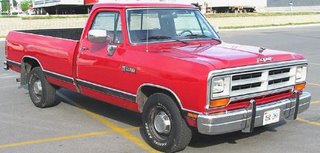
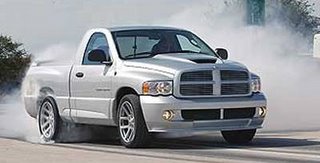
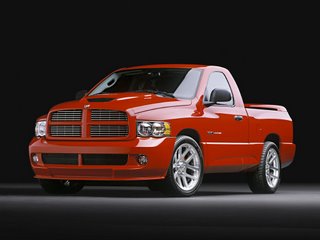
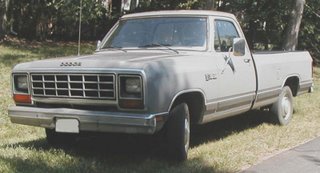
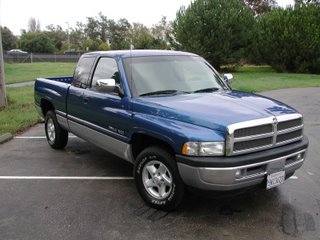
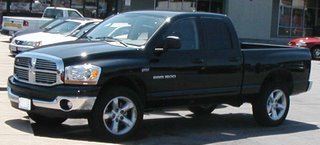
The Ram is a full-size pickup truck from DaimlerChrysler's Dodge brand. The name was first used in 1981 on the redesigned D Series, though it came from the hood ornament used in the 1930s and 1940s trucks.
Dodge Ram trucks have been named Motor Trend magazine's Truck of the Year twice. The second-generation Ram won the award in 1994, and the third-generation Ram Heavy Duty won the award for 2003.
The Ram is built at Saltillo Truck Assembly in Saltillo, Coahuila, Mexico, Saint Louis Assembly North in Fenton, Missouri, and Warren Truck Assembly in Warren, Michigan.
The first-generation Ram trucks, introduced in 1981, kept the previous generation's model designations: "D" meant rear wheel drive while the "W" Power Ram meant four wheel drive. Like Ford, Dodge used 150 to mean a half-ton truck, 250 to indicate a ¾-ton, and 350 for one-tons. Standard cab, "Club" extended cab, and crew cab versions were offered along with 6.5 ft and 8 ft bed lengths and "Utiline" and "Sweptline" styled boxes. Externally, the first-generation Rams were facelifted versions of the previous generation Dodge D Series pickups (known as the Adventurer) that dated back to 1972. The new model introduced wraparound taillamps, single rectangular headlamps, and squared-off body lines.
100 models were added for 1984, replacing the previous "Miser" trim level available on the D150. A "Ram-Trac" shift-on-the-fly transfer case was added for 1985, and both the crew cab and Utiline flared bed were dropped for 1986. Also for 1986, a new crossbar grille appeared. The 5.2 L engine received electronic fuel injection in 1988.
The engines were updated for 1989. The Slant-6 was dropped in favor of a 3.9 L fuel injected V6 with 25% more power. The 5.9 L V8 also received fuel injection that year for 20 hp (15 kW) more power. Rear anti-lock brakes were also made standard.
The Ram 100 model designation was dropped and these models folded back into the "150" range for 1990, and the grille was redesigned for 1991. The engines were substantially upgraded for 1992 (3.9L and 5.2L) and 1993 (5.9) with multiport fuel injection and new manifolds and cylinder heads for much higher output. These engines recived the "Magnum" designation.
These trucks, though popular with fleets, sold poorly compared to the Ford F-Series and the General Motors C/K Trucks, with just under 100,000 units sold most years of their production.A Cummins turbodiesel option was added for big (400 ft.lbf / 542 Nm) torque needs. This engine, part of the Cummins B Series, is the largest straight-6 engine ever produced for a passenger vehicle. These early B Series engines have been known to go 350,000 miles before their first overhaul.
The Ram line was redesigned for 1994 and was an instant hit. It featured a semi truck-look front end with separate fenders and an oversized grille; but it was the 8.0 L V10 engine and its 450 ft.lbf (610 Nm) of torque that was noticed by serious users. Models were now the 1500 (half-ton), 2500 (¾-ton), and 3500 (one-ton).
A natural gas version of the 5.2 L engine debuted for 1995. In 1998, Dodge introduced the "Quad-Cab", which used rear-hinged pillarless doors in the back for a wide cab opening. The Cummins ISB engine, introduced in 1999, was an unusual multi-valve pushrod engine.
The redesigned 1994 Ram was a tremendous sales success, with sales rocketing from 100,000 units in 1993 to 240,000 in 1994, 280,000 in 1995, and nearly 400,000 in 1996. Sales of this generation peaked at just over 400,000 in 1999 before declining against the redesigned Ford and GM trucks, which utilized some of the Ram's design elements. By 2001, the Ram was back to 350,000 sales.
The third-generation Ram debuted for 2002. This represented a major update including all new frame, suspension, powertrains, interiors, and sheetmetal. It included an even larger grille, and special models kept interest up as most competitors had adopted the Ram's separate-fender look. The Cummins ISB Diesel was on the Ward's 10 Best Engines list for 2004. The four wheel drive light duty trucks (1500 series) lost their live axles in trade for an independent front suspension, but the heavy duty (2500 and 3500 series) retained the live axles for maximum durability and load capacity.
The redesigned DR trucks reignited sales, with 400,000 sold in 2002 and nearly 450,000 sold in 2003, a new high point for the Ram name. At the same time, both Ford and GM trucks were declining from a 2001 peak over 900,000 to the 850,000 area. But the Ram's sales could not keep up with the eleventh-generation F-150 and the strong Nissan Titan in 2004 and 2005, with 400,543 Rams sold that year. The Toyota Tundra had never posed much of a threat, but a much larger 2007 model may erode Dodge sales further.
Dodge Ram trucks have been named Motor Trend magazine's Truck of the Year twice. The second-generation Ram won the award in 1994, and the third-generation Ram Heavy Duty won the award for 2003.
The Ram is built at Saltillo Truck Assembly in Saltillo, Coahuila, Mexico, Saint Louis Assembly North in Fenton, Missouri, and Warren Truck Assembly in Warren, Michigan.
The first-generation Ram trucks, introduced in 1981, kept the previous generation's model designations: "D" meant rear wheel drive while the "W" Power Ram meant four wheel drive. Like Ford, Dodge used 150 to mean a half-ton truck, 250 to indicate a ¾-ton, and 350 for one-tons. Standard cab, "Club" extended cab, and crew cab versions were offered along with 6.5 ft and 8 ft bed lengths and "Utiline" and "Sweptline" styled boxes. Externally, the first-generation Rams were facelifted versions of the previous generation Dodge D Series pickups (known as the Adventurer) that dated back to 1972. The new model introduced wraparound taillamps, single rectangular headlamps, and squared-off body lines.
100 models were added for 1984, replacing the previous "Miser" trim level available on the D150. A "Ram-Trac" shift-on-the-fly transfer case was added for 1985, and both the crew cab and Utiline flared bed were dropped for 1986. Also for 1986, a new crossbar grille appeared. The 5.2 L engine received electronic fuel injection in 1988.
The engines were updated for 1989. The Slant-6 was dropped in favor of a 3.9 L fuel injected V6 with 25% more power. The 5.9 L V8 also received fuel injection that year for 20 hp (15 kW) more power. Rear anti-lock brakes were also made standard.
The Ram 100 model designation was dropped and these models folded back into the "150" range for 1990, and the grille was redesigned for 1991. The engines were substantially upgraded for 1992 (3.9L and 5.2L) and 1993 (5.9) with multiport fuel injection and new manifolds and cylinder heads for much higher output. These engines recived the "Magnum" designation.
These trucks, though popular with fleets, sold poorly compared to the Ford F-Series and the General Motors C/K Trucks, with just under 100,000 units sold most years of their production.A Cummins turbodiesel option was added for big (400 ft.lbf / 542 Nm) torque needs. This engine, part of the Cummins B Series, is the largest straight-6 engine ever produced for a passenger vehicle. These early B Series engines have been known to go 350,000 miles before their first overhaul.
The Ram line was redesigned for 1994 and was an instant hit. It featured a semi truck-look front end with separate fenders and an oversized grille; but it was the 8.0 L V10 engine and its 450 ft.lbf (610 Nm) of torque that was noticed by serious users. Models were now the 1500 (half-ton), 2500 (¾-ton), and 3500 (one-ton).
A natural gas version of the 5.2 L engine debuted for 1995. In 1998, Dodge introduced the "Quad-Cab", which used rear-hinged pillarless doors in the back for a wide cab opening. The Cummins ISB engine, introduced in 1999, was an unusual multi-valve pushrod engine.
The redesigned 1994 Ram was a tremendous sales success, with sales rocketing from 100,000 units in 1993 to 240,000 in 1994, 280,000 in 1995, and nearly 400,000 in 1996. Sales of this generation peaked at just over 400,000 in 1999 before declining against the redesigned Ford and GM trucks, which utilized some of the Ram's design elements. By 2001, the Ram was back to 350,000 sales.
The third-generation Ram debuted for 2002. This represented a major update including all new frame, suspension, powertrains, interiors, and sheetmetal. It included an even larger grille, and special models kept interest up as most competitors had adopted the Ram's separate-fender look. The Cummins ISB Diesel was on the Ward's 10 Best Engines list for 2004. The four wheel drive light duty trucks (1500 series) lost their live axles in trade for an independent front suspension, but the heavy duty (2500 and 3500 series) retained the live axles for maximum durability and load capacity.
The redesigned DR trucks reignited sales, with 400,000 sold in 2002 and nearly 450,000 sold in 2003, a new high point for the Ram name. At the same time, both Ford and GM trucks were declining from a 2001 peak over 900,000 to the 850,000 area. But the Ram's sales could not keep up with the eleventh-generation F-150 and the strong Nissan Titan in 2004 and 2005, with 400,543 Rams sold that year. The Toyota Tundra had never posed much of a threat, but a much larger 2007 model may erode Dodge sales further.
No comments:
Post a Comment